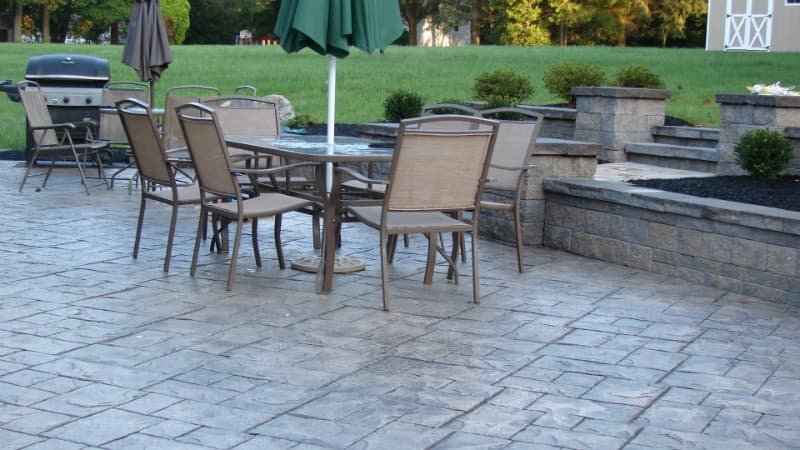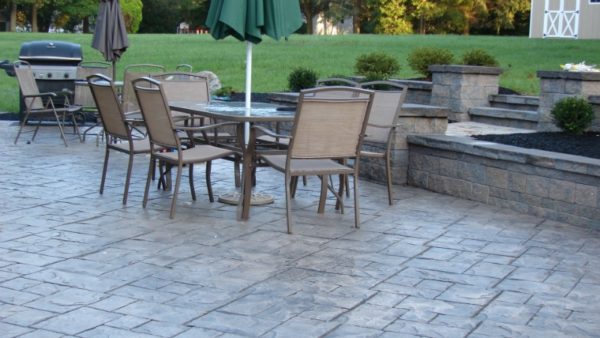Thinking about remodeling your back patio, driveway, sidewalk or pool deck? You should consider installing stamped concrete for your next home improvement project. Stamped concrete lasts longer and has lower maintenance costs than other traditional materials and increases the value of your home. Here’s what you can expect from your concrete contractor during your project design, installation, and maintenance phases.
Design Phase: Initial Consultation with your Concrete Contractor
The most important thing to consider when hiring a concrete contractor is a stamped concrete specialty, as it requires specialized tools and background knowledge. Take the time to shop around for a concrete contractor with extensive experience in designing, installing, and maintaining stamped concrete. Check out their previous projects and look for good reviews and references regarding their work.
Once a concrete contractor is selected, the brainstorming phase can begin. There are endless possibilities for stamped concrete, so having a general idea ahead of time will expedite the process for both you and your concrete contractor. Consider possible color and pattern combinations that might interest you and compliment your other landscaping choices.
If you have any concerns or questions regarding any element of your project, the design phase is the time to address them. Concerns about removing existing stone or concrete, preparation of the space, timelines, and costs should all be addressed at this point.
Concrete stamping cannot be performed in inclement weather. It is important to select a timeframe for installation that best accommodates both you and your concrete contractor and also incorporates some flexibility in case of weather delays.
Installation Phase: Stamped Concrete Process
What does the process of stamping concrete look like? This guide illustrates the process for installing stamped concrete:
- Pouring the concrete: First, the space is cleared, and a concrete base is poured. At this point, timing is of the essence. The concrete needs to be firm enough to allow the contractors to work on the surface, but soft enough to allow the pattern to imprint.
- Color hardeners: Applied by hand and with a specialized tool, color hardeners function to strengthen and add color to your stamped concrete. Stamped concrete can be colored later in the process with a stain or dye, so this step can be skipped.
- Adding a release agent: Stamping concrete uses “stamping mats,” which are rubber mats used to add a pattern or stamp to your concrete as it dries. Release agents prevent these mats from sticking to the concrete.
- Check the plasticity of the concrete: Before stamping begins, the contractor must test the surface of the concrete to ensure it is ready to hold the weight of the contractor while accepting the stamping pattern.
- Edge pre-texturing: This step ensures that the edges of your stamped concrete slab retain the same texture and shape after the rest is textured with mats. This step generally involves special flex-mats to help edges keep their shape.
- Apply mats: Once the edges have been textured, mats are laid in a row to start the pattern. Making sure that the edges of the mats line up will guarantee that your stamped concrete keeps its pattern.
- Detail work: Once the stamping is finished and your concrete dries, your contractor can address any detailing issues that may have arisen. This step generally is done with hand tools by the contractor.
- Applying a curing compound: As the concrete continues to dry, your contractor may wash the release agent from the surface and then apply a curing compound to treat the surface.
- Install joints: Joints help prevent the concrete from developing splits and cracks and can be added either before or after the concrete dries depending on the tools used.
- Seal the concrete: Once the concrete has finished drying, your contractor will apply a sealant on the surface to extend its lifespan.
Maintenance Phase: How to keep your Stamped Concrete looking like new
Concrete is unlike stone and brick in the sense that it generally lasts longer without much maintenance, generally anywhere from 10-20 years. However, cracks and splits are common and easily solved by re-sealing and treating your stamped concrete. If you notice that your stamped concrete could use a little fine-tuning, reach out to your concrete contractor to help you out.
Do you think stamped concrete could make a great addition to your home? Contact Morrison Custom Concrete today for a consultation!




